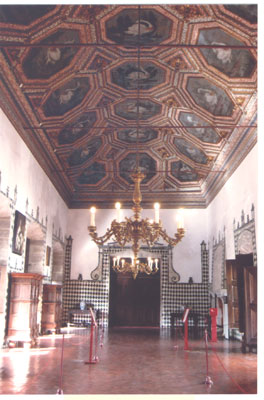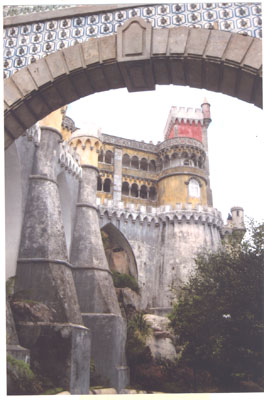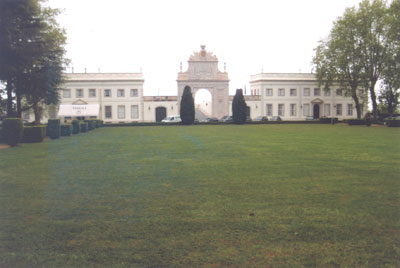Palaces of Sintra
This item appears on page 61 of the December 2012 issue.
(Part 2 of 2 on Portugal)
Sintra is one of the highlights of Portugal. It’s the kind of place that should be visited no matter how limited the time one has in this small Western European country wedged between Spain and the Atlantic. To miss spending even a few hours there would be like celebrating a birthday without the birthday cake.
Located just 15 miles northwest of Lisbon, Sintra is set in the midst of wooded hills and open countryside. It’s no surprise that for more than 600 years it’s served as a summer retreat for royalty as well as those with enough money to build the sumptuous villas dotting the hillsides. It is a cool paradise escape from the summertime heat of nearby Lisbon.
My husband, Paul, and I spent three days in Sintra in April 2012 exploring two royal palaces while living in a third palace.
Palace with Moorish roots
The first palace we visited was the National Palace, located in Sintra’s Old Town. It’s an enormous place that has evolved over the course of almost a thousand years into the hybrid structure you see today.
Its roots go back to the 10th century, when a Moorish governor built his residence there. (The Moors from North Africa occupied Portugal from the early eighth century to the mid 13th century.) In 1147, Afonso Henriques reconquered Lisbon and surrounding areas from the Moors and occupied the residence.
It was not until the late 14th century that the present structure began to take shape under João I, who built the Gothic facade and the enormous kitchens with their equally enormous and very distinctive chimneys. The royal family used this palace as a summer retreat, a tradition that continued until the late 19th century.
In the early 16th century, Manuel I added his distinctive touch, a style called Manueline, characterized by architectural intricacy and embellishment.
Today, visitors each guide themselves through the palace at their own pace (unless herded through with a package tour group — something to be avoided, if possible). Each room is unique, but what should not be missed are the Sala das Pegas (Hall of the Magpies), with 136 magpies painted on the 16th-century ceiling, the Sala dos Cisnes (Hall of the Swans), with swans decorating the octagonal panels of the ceiling, and the Sala dos Brasões (Hall of the Coats of Arms), with 18th-century blue-and-white tiles covering the lower walls plus a fantastic domed ceiling covered with the coats of arms of 72 of Portugal’s noble families.
Also not to be missed are the kitchens, complete with enormous pots and pans, and the chapel, with a Moorish-design mosaic floor that resembles a rich carpet.
Royal summer palace
Very different from the National Palace is Pena Palace, located just outside Sintra on one of the peaks of the surrounding Serra de Sintra. It is a comparatively new palace, built in the mid 19th century by Queen Maria II and her consort, Ferdinand of Saxe-Coburg-Gotha, who was cousin to both Albert, Queen Victoria’s husband, and “Mad” Ludwig of Bavaria.
Built atop the ruins of a 16th century monastery, this palace — also once a summer retreat — is a fantasy of turrets, towers and domes, with Moorish, Gothic and mythological touches everywhere. It is a visual delight, especially if you visit on your own, taking time to note the richness of the details.
Not to be missed are the exterior archways, one in the shape of a Moorish-style horseshoe, another with crenellated turrets, a third with a ferocious-looking merman (with two fish tails) above an interior courtyard bay window.
The palace is on an intimate scale, more like a private home than a palace, except for the enormous ballroom. To offset its grandeur is the small, jewel-box room called the Arab Room, with intricate stucco work.
Palace as home
The third palace was one Paul and I actually lived in for two nights, the Tivoli Palácio de Seteais, located a 15-minute cab ride from the National Palace and Pena Palace.
The Tivoli Palácio was completed in 1787 by a Dutch diplomat on lands given to him by the Marquis of Pombal (responsible for the rebuilding of Lisbon after the earthquake of 1755). The palace is neoclassical in style and is set in wonderful gardens overlooking the countryside in one direction and an eighth-century Moorish castle high up in the mountains in the other direction.
The Tivoli Palácio is a jewel of a place, where one can suspend reality pretending to be a lord of the manor living in opulent splendor. We’ve stayed in lots of wonderful hotels over our many years of travel. This was one of the best.
It’s top-notch — glittering public rooms; grand staircase; ornate ornaments fit for royalty; elegant bedrooms; a restaurant serving the best dinner we had in our 17 days in Portugal, and an intimate bar for simpler meals and for drinks.
To top it off, our room came with a large terrace from which we could see both the manicured gardens and the countryside with its vineyards and villas. A crystal carafe of port wine awaited us on a table beside the window and the view. Such an elegant way to welcome us to the splendors of Sintra!
If you go…
The grandeur of the Tivoli Palácio de Seteais (Rua Barbosa do Bocage 8, 2710-517 Sintra, Portugal; phone [+351] 21 923 3200, fax 923 4277) can be yours too, even if only for a few days. Rates for rooms begin at €200 (near $250) per night, depending on season. Inquire about packages that include dinner.
If not staying there or if on a day excursion, consider stopping by for lunch or dinner and a stroll through the public rooms and gardens. Dinner with appetizer, main course, dessert, a glass of wine and coffee should cost about $150 for two, this for a meal fit for a king.
Try to allow at least an overnight in Sintra. Two nights is better. Three is best. There’s so much to see, including more regal houses and gardens, and the best way to see them is to savor them slowly.
Trains run from Lisbon’s Rossio Station to Sintra frequently (about every half hour, when we visited) and take about 45 minutes. We opted, however, to take a limousine arranged for us by the Tivoli Palacio de Seteais; the trip took 25 minutes, door to door, and cost €65 ($81).
We flew TAP (800/221-7370), Portugal’s national carrier, from Newark to Lisbon. With the economy section almost full, I made a request and we were upgraded to fabulous business class, with seats that we could turn into fully reclining sleeping “pods” after finishing a first-class dinner complemented by a wide selection of Portuguese wines and port wines.



